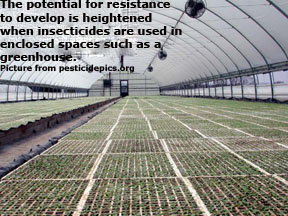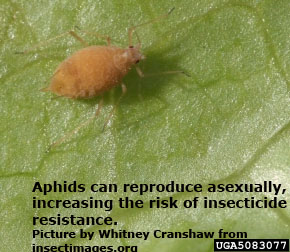The repeated use of virtually any insecticide is capable of selecting for resistance in insects. With the introduction of every new insecticide class, cases of resistance surfaced within two to 20 years. The speed at which a species develops resistance to an insecticide depends on many factors. However, history clearly shows that the potential for resistance to develop and spread is heightened under the following conditions:
 The insecticide is used in enclosed areas such as greenhouses where there is little or no immigration of susceptible insects.
The insecticide is used in enclosed areas such as greenhouses where there is little or no immigration of susceptible insects.- The insects have multiple generations per year and many offspring per generation. This effect can be compounded with insects that reproduce asexually, such as aphids.
- The insects are highly susceptible to the insecticide. If a species is highly susceptible, only resistant insects survive the treatment and reproduce.
- The insect population has a high initial frequency of the genes conferring resistance.
 When insecticides are used under these conditions, it is imperative to treat alternate generations of pests with pesticides that have different modes of action or a non-chemical tactic.
When insecticides are used under these conditions, it is imperative to treat alternate generations of pests with pesticides that have different modes of action or a non-chemical tactic.
Compiled by Dr. Wayne Buhler, PhD
